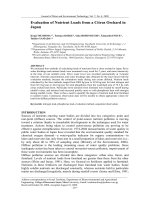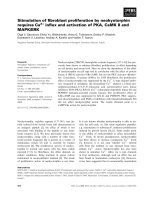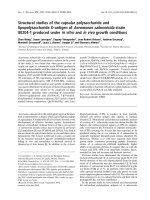Evaluation of botanicals, bio agents and fungicides against stem bleeding of coconut caused by Thielviopsis Paradoxa under in vitro conditions
Bạn đang xem bản rút gọn của tài liệu. Xem và tải ngay bản đầy đủ của tài liệu tại đây (145.16 KB, 6 trang )
Int.J.Curr.Microbiol.App.Sci (2019) 8(2): 2690-2695
International Journal of Current Microbiology and Applied Sciences
ISSN: 2319-7706 Volume 8 Number 02 (2019)
Journal homepage:
Original Research Article
/>
Evaluation of Botanicals, Bio Agents and Fungicides against Stem Bleeding
of Coconut caused by Thielviopsis paradoxa under in vitro Conditions
G.K. Sudarshan1*, G.S. Chandrashekara1, T.B. Basavaraju1,
K.B. Palanna2 and G.P. Mutthuraju1
1
2
University of Horticultural Sciences, Bagalkot-587104, Karnataka, India
Department of Plant Pathology, GKVK, Bangalore-560065, Karnataka, India
*Corresponding author
ABSTRACT
Keywords
Coconut,
Fungicides,
Stem bleeding,
Thielviopsis
paradoxa, Plant
extracts, Bio agents
Article Info
Accepted:
20 January 2019
Available Online:
10 February 2019
Stem bleeding disease caused by Thielaviopsis paradoxa is one of the major diseases of
coconut in almost all the coconut growing regions of Karnataaka. Bioefficacy of five
botanicals viz. Allium sativa, Nerium olender, Tinospora cordifolia, Osimum sanctum and
Aegle marmelos, Seven isolates namely Trichoderma viridae (GKVK), Trichoderma
harzianum (GKVK), Trichoderma asperillum (GKVK), Trichoderma harzianum (HRS,
NBAII, KRN and MYS) and ten systemic and three contact fungicides were evaluated
under in vitro conditions against Thielviopsis paradoxa. Among the five botanicals
evaluated only Allium sativa found significantly superior and showed complete inhibition
of the growth of the pathogen at 15% and 20% concentration followed by Osimum
sanctum found effective and has recorded eighty five per cent inhibition at 20%
concentration. Among the antagonists tested Trichoderma viridae (GKVK) was found
superior over all other bio agents by recording maximum inhibition of 78.00 per cent
followed by Trichoderma asperillum (GKVK) which has recorded 74.00 per cent. Among
the thirteen fungicides evaluated standard check Carbendazim 50%WP @ 0.1%,
Difenoconazole 25% EC @ 0.1%, Propiconazole 25% %, Tebuconazole 25.9%
EC @ 0.15% and Thiophanate Methyl 70%WP @ 0.28% has recorded cent per cent
inhibition and showed superior over other fungicides .The Azoxystrobin 23%SC @ 0.1%
and Pencycuron 22.9%SC @ 0.1% were recorded least per cent inhibition on 9 DAI.
Introduction
Stem bleeding disease of coconut caused by
Thielviopsis paradoxa (de seyness) von
Hohnel is a debilitating disease and is widely
prevalent in all coconut growing areas of the
country. The disease was first reported from
Sri Lanka (Petch, 1906) and later reported in
India (Sundararaman, 1922) and other
countries. In India, the disease is prevalent in
almost all coconut growing states. The disease
has been found to occur in all soil types, but
more in laterite soils and sandy soils on
seashore or backwater areas (Nambiar, 1994).
The pathogen is a soil borne pathogen and
enters the plant through growth cracks present
on the stem and causes cortical decay. The
disease is characterized by development of
2690
Int.J.Curr.Microbiol.App.Sci (2019) 8(2): 2690-2695
dark brown patches appearing at the basal
portion of the trunk. A dark or reddish brown
liquid exudates from the longitudinal cracks
present on the stem bark. Subsequently, the
liquid dries up and turns black; the tissues
below the lesions become water soaked and
get discolored. The lesion spread upwards as
the disease progresses. In the advanced
stages, stem gets tapered and crown size gets
reduced leading to gradual reduction in yield.
The earliest recommendation for the control
of the disease was chiseling of the affected
tissues and application of hot coal tar. This
did not always results in giving effective
control of the disease (Nambier and Kalpana
sastry, 1988). Soil drenching with calixin
0.1% (Radhakrishnan, 1990) and root feeding
with Bavistin 5% or Calixin 5% (Ramanujam
et al, 1993), have been found to reduce the
disease to some extent. Biological control
through
the
use
of
antagonistic
microorganism
and
locally
available
botanicals for the development of integrated
management strategy against the disease has
emerged as available option (Alvindia and
Natsuaki, 2008). Trichoderma spp., is
considered to be antagonistic to many soil
borne and plant pathogenic fungi (Prasad et
al., 2002): Ramanujam et al., 2005 and
Ranjana Chakrabarty et al., 2013). Soil
application of Neem cake to the affected
palms was found to reduce the population of
T. paradoxa and encourage the antagonistic
population in soil (Sanal Kumar et al., 1990).
Locally available botanicals secrete antifungal
metabolites that substantiate their action
against certain fungi. IDM practices used to
develop a combination of specific chemicals
with bio-agents and botanicals with an aim to
reduce the non-availability of bioagents and
botanicals at specific period of time sand
which are also environmental friendly. Since
the pathogen is soil borne, it is essential to
adopt an integrated approach involving
antagonistic organisms, fungicides and
acqueous plant extract for effective disease
management. The present study was carried
out to investigate the role of all three
components in inhibiting the growth of the
fungus in in vitro and subsequent formulation
of IDM practices against the pathogen.
Materials and Methods
The study was carried out at Horticulture
Research Station, Arsikere under All India
coordinated research project. The fungus
Thielviopsis paradoxa was isolated from
diseased sample collected from stem bleeding
affected coconut palm on potato dextrose
agar. The six botanicals viz. Alliumsativa,
Nerium olender, Tinospora cordifolia,
Osimum sanctum, Aegle marmelos and
Azadirecta indica were conducted at four
concentrations by employing food poison
technique (Nene, 1971). Fresh plant part
materials were collected and washed first in
tap water and then in distilled water. Aqueous
plant extract was prepared by grinding 100 g
fresh samples with 100 ml distilled water
(w/v) using a blender and filtrate was
collected by passing through double layered
muslin cloth. Finally filtrate thus obtained
was used as stock solution. The seven bio
control agents which were isolated from the
soil samples of coconut rhizosphere from the
different location i.e. Trichoderma viridae
(GKVK), Trichoderma harzianum (GKVK),
Trichoderma
asperillum
(GKVK),
Trichoderma harzianum (HRS), Trichoderma
harzianum (NBAII), Trichoderma harzianum
(KRN) and Trichoderma harzianum (HRS)
were evaluated by using dual culture method.
Radial growth of Thielviopsis paradoxa was
measured at different days after inoculation
and the per cent inhibition was calculated.
While ten systemic and three contact
fungicides
namely
Azoxystrobin
23%%, Carbendazim50%WP @
0.1%, Carboxin 37.5 + Thiram 37.5% @DS
@ 0.3%, Copper oxy chloride 70%WP @
0.3%,
Difenoconazole 25%%,
2691
Int.J.Curr.Microbiol.App.Sci (2019) 8(2): 2690-2695
Pencycuron 22.9% %, Propiconazole
25% %, Tebuconazole 25.9% EC
@0.15%, Tebuconazole + Trifloxystrobin
75%%, Tetraconazole 3.8%w/w
EW @0.1%, Tetraconazole 3.8%w/w EW @
0.15%, Thiophanate Methyl 70%WP @
0.28% and standard check Hexaconazole 5%
%
were evaluated at their
recommended concentration using food
poison technique. The radial growth of the
test fungal colony recorded on 10th day when
maximum growth was observed in untreated
control plates. The percent inhibition of the
mycelia growth over control was calculated
using formula given by Vincent (1942).
C-T
I=
X 100
C
I = % inhibition of mycelia growth
C= radial growth of fungus in control
T = radial growth of fungus in treatment
Results and Discussion
Influence of botanicals on mycelial growth of
T. paradoxa was presented in Table 1.
The results clearly reveal that among the six
botanicals evaluated only Allium sativa found
significantly superior and showed complete
inhibition of the growth of the pathogen at
15% and 20% concentration followed by
Osimum sanctum found effective in inhibiting
the growth of Thielviopsis paradoxa at same
concentration and they have recorded 65 - 79
per cent inhibition (Table 1).
Seven bio control agents which were
collected from the different locations were
tested against Thielviopsis paradoxa by dual
culture method. The results revealed that, all
the antagonists significantly reduced the
growth of Thielviopsis paradoxa by recording
mycelial inhibition ranging from 61.33 to
78.00 per cent (Table 2).
Among the antagonists tested Trichoderma
viridae (GKVK) was found superior over all
other bio agents by recording maximum
inhibition of 78.00 per cent followed by
Trichoderma asperillum (GKVK) which has
recorded 74.00 per cent. Least inhibition of
61.33 per cent was recorded in Trichoderma
harzianum (KRN).
Experiment on in vitro evaluation of ten
systemic and three contact fungicides were
carried out against Thielviopsis paradoxa
(Table 3) and it was noticed that among the
thirteen fungicides evaluated Among the
thirteen fungicides evaluated standard check
Carbendazim
50%
WP
@0.1%,
Difenoconazole
25%
%,
Propiconazole 25% %, Tebuconazole
25.9% % and Thiophanate Methyl
70%WP @ 0.28% has recorded cent percent
inhibition and showed superior over other
fungicides .The Azoxystrobin 23%%
and Pencycuron 22.9%SC @ 0.1% were
recorded
least per cent inhibition on 9
DAI..
The results in conformity with Ramanujam et
al., 2005 and Ranjan Chakrabarty et al., 2013
where Allium sativum extract completely
inhibited the growth of the pathogen.
Trichoderma viridae was found to be most
effective with 61.62% inhibition followed by
T. harzianum and T. virens with 60.80 and
59.49 per cent inhibition respectively, over
control after 96h of incubation period.
The fungicides, Calixin (Tridemorph 80EC)
@ 0.3% showed 100 per cent inhibition over
control whereas Ridomil MZ-72, Blitox-50
and Bavistin showed 92.00, 91.55 and 91.44
per cent inhibition over control after 144h of
incubation respectively.
2692
Int.J.Curr.Microbiol.App.Sci (2019) 8(2): 2690-2695
Table.1 In vitro evaluation of different botanicals against stem bleeding of coconut caused by Thielviopsis paradoxa
Trt
No.
Treatment
Part
used
% Inhibition of Thielviopsis paradoxa
Concentration
5%
10%
15%
20%
3DAI
6DAI
9DAI
3DAI
6DAI
9DAI
3DAI
6DAI
9DAI
3DAI
6DAI
9DAI
T1
Allium sativa
Clove
77.63
(61.77)
70.94
(57.40)
73.33
(58.91)
80.48
(63.78)
79.81
(63.30)
81.56
(64.58)
100.00
(90.00)
100.00
(90.00)
100.00
(90.00)
100.00
(90.00)
100.00
(90.00)
100.00
(90.00)
T2
Tinospora
cordifolia
Leaf
2.85
(8.58)
5.77
(13.77)
0.00
(0.00)
1.90
(7.10)
18.19
(25.75)
18.44
(25.43)
0.49
(1.80)
20.48
(26.90)
29.78
(33.05)
2.94
(8.72)
21.13
(27.29)
0.00
(0.00)
T3
Nerium olender
Leaf
3.33
(10.37)
6.75
(14.68)
1.56
(4.44)
24.29
(29.51)
21.43
(27.57)
19.78
(26.39)
27.10
(31.35)
23.27
(28.83)
10.67
(19.06)
27.57
(31.64)
25.14
(30.06)
21.42
(19.82)
T4
Osimum sanctum
Leaf
48.08
(43.90)
33.71
(35.46)
4.22
(11.74)
58.10
(49.67)
57.87
(49.53)
49.11
(44.49)
74.88
(59.92)
75.47
(60.32)
76.00
(60.67)
77.34
(61.58)
77.90
(61.97)
85.06
(63.92)
T5
Aegle marmelos
Leaf
3.80
(11.10)
12.54
(20.51)
0.00
(0.00)
5.24
(10.89)
25.43
(30.26)
11.78
(20.02)
13.28
(21.32)
24.49
(29.64)
1.78
(7.45)
13.79
(21.76)
23.00
(28.65)
18.43
(18.84)
T6
Azadirecta indica
Leaf
48.09
(43.91)
39.56
(38.97)
11.33
(19.62)
49.05
(44.45)
43.74
(41.40)
12.89
(12.22)
59.10
(50.25)
66.45
(54.61)
65.56
(54.07)
69.43
(56.46)
66.86
(54.86)
60.37
(60.07)
SEm±
1.17
1.36
1.28
1.82
0.51
0.56
0.91
0.37
0.57
1.10
0.60
0.36
CD @ 1%
4.70
5.47
5.13
7.30
2.03
2.24
3.66
1.49
2.28
4.40
2.43
1.45
2693
Int.J.Curr.Microbiol.App.Sci (2019) 8(2): 2690-2695
Table.2 In vitro evaluation of Bio control agents against stem bleeding of coconut caused by
Thielviopsis paradoxa
Treatment
No.
T1
Bio control agents
Trichoderma viridae(GKVK)
T2
Trichoderma harzianum (GKVK)
T3
Trichoderma asperillum(GKVK)
T4
Trichoderma harzianum (HRS)
T5
Trichoderma harzianum (NBAII)
T6
Trichoderma harzianum (KRN)
T7
Trichoderma harzianum (MYS)
% Inhibition of Thielviopsis paradoxa
3DAI
6DAI
9DAI
39.28
73.96
78.00
(38.79)
(59.33)
(62.03)
24.12
73.67
64.67
(29.24)
(59.14)
(53.53)
22.16
70.51
74.00
(28.00)
(57.11)
(59.36)
23.16
75.47
72.89
(28.69)
(60.32)
(58.62)
22.21
61.97
67.56
(27.95)
(51.94)
(55.28)
19.21
58.19
61.33
(25.82)
(49.72)
(51.55)
23.98
64.05
70.22
(29.29)
(53.16)
(56.96)
0.73
0.33
0.43
11.56
2.93
3.83
SEm±
CD(P=0.01)
Table.3 In vitro evaluation of fungicides against stem bleeding of coconut caused by
Thielviopsis paradoxa
Treatment
No.
T1
Fungicide
Dosage (%)
Azosystrobin 23%SC
0.1
T2
Carbendazim50%WP
0.1
T3
Carboxin 37.5 + Thiram 37.5%DS
0.3
T4
Copper oxy chloride50%WP
0.3
T5
Difenoconazole 25%EC
0.1
T6
Hexaconazole 5%SC
0.1
T7
Pencycuron 22.9%SC
0.1
T8
Propiconazole 25%EC
0.1
T9
Tebuconazole 25.9%EC
0.15
T10
Tebuconazole+ Trifloxystrobin75%WG
0.04
T11
Thiophanate Methyl 70%WP
0.28
T12
Tetraconazole3.8% w/w(4%w/v)EW
0.1
T13
Tetraconazole3.8% w/w(4%w/v)EW
0.15
SEm±
CD(P=0.01)
2694
% Inhibition of T. paradoxa
3DAI
6DAI
35.73
4.00
(36.60)
(8.98)
100.00
100.00
(90.00)
(90.00)
100.00
100.00
(90.00)
(90.00)
100.00
100.00
(90.00)
(90.00)
100.00
100.00
(90.00)
(90.00)
100.00
78.13
(90.00)
(62.13)
32.80
0.00
(34.93)
(0.00)
100.00
100.00
(90.00)
(90.00)
100.00
100.00
(90.00)
(90.00)
77.76
82.13
(61.89)
(65.00)
100.00
100.00
(90.00)
(90.00)
100.00
74.40
(90.00)
(59.61)
100.00
76.00
(90.00)
(60.69)
0.67
1.07
5.08
8.18
9DAI
1.56
(6.21)
100.00
(90.00)
85.37
(67.53)
100.00
(90.00)
100.00
(90.00)
67.37
(55.17)
1.82
(7.52)
100.00
(90.00)
100.00
(90.00)
81.18
(64.32)
100.00
(90.00)
63.46
(52.81)
67.10
(55.01)
0.63
4.77
Int.J.Curr.Microbiol.App.Sci (2019) 8(2): 2690-2695
References
Alvindia, D. G. and Natsuaki, K. T. 2009.
Biocontrol
activities
of
Bacillus
amylolifaciens DGA 14 isolated from
banana fruit surface against banana
crown rot- causing pathogens. Crop
Prot. 28: 236- 242.
Nambiar, K.K.N.1994. Diseases and disorders
of coconuts. In: Advances in Horticulture
vol. 10 Plantation and Spice Crops Part
2. K.L.Chadha and P. Rethinam, (Eds.).
Malhotra Publishing House, New Delhi.,
pp-857-882 .
Nambiar, K. K. N. and Kalpana Sastry, R. 1988.
Stem bleeding disease of coconut:
Current status and Approaches for its
control. Philippine J. Coconut studies.
12(9): 13-14.
Nene, Y. L. 1971. Fungicides in plant disease
control. Oxford and IBH Publ. Co. New
Delhi., pp. 386.
Petch, T. 1906, Diseases of the coconut palm.
Trop. Agriculturist. 27:490-491.
Prasad, R. D., Rangeshwaran, R., Hedge, S. V.
and Anuroop, C. P. 2002. Effect of soil
application of Trichoderma harzianum
on pigeon pea wilt caused by Fusarium
udum under field conditions. Crop Prot.
21: 293-297.
Radhakrishnan, T.C.1990, Control of stem
bleeding disease of coconut. Indian
Coconut J. 20(9):13-14.
Ramanujam, B., Nambiar, K.K.N. and Anil
Kumar. 1993. Chemical control of stem
bleeding disease of coconut. In:
Advances in coconut Research and
Development, (Eds.) M.K. Nair, H.H.
Khan, P. Gopalasundaram and E.V.V.B.
Rao Oxford and IBH publishing Co. Pvt.
Ltd., New Delhi., pp- 615-616.
Ramanujam, B., Nambiar, K. K. N and Iyer, R.
2005. Effect of systemic fungicides,
aqueous extracts of oil cake and
inorganic
soil
amendment
on
Thielaviopsis
paradoxa
and
its
antagonistic fungi in vitro. J. Plantation
Crops. 33(2): 107-111.
Ranjana chakrabarty, G.C.Acharya and
T.C.Sarma, 2013, Effect of Fungicides,
Trichoderma and Plant extracts on
mycelial
growth
of
Thielviopsis
paradoxa, under in vitro condition. The
Bioscan .8(1): 55-58.
Ranjana Chakrabartty, G.C. Acharya and T.C.
Sarma. 2013. Management of Basal stem
rot of Areca nut (Areca catechu L.) under
Assam condition. The Biosean.8
(4):1291-1294.
Sanal kumar, R., Rohini Iyer and Nambiar,
K.K.N, 193, In vitro inhibition of
Thielviopsis paradoxa by mycoflora
from coconut basin. In advances in
coconut Research and Development,
(Eds.) M.K. Nair, H.H. Khan, P.
Gopalasundaram and E.V.V.B. Rao
Oxford and IBH publishing Co. Pvt.
Ltd., New Delhi. pp 613-614.
Sundraraman, S. 1922. The coconut bleeding
disease. Pusa Agr. Res. Inst. Bull. 127:
8p.
Vincent, J.M.1947. Distortion of fungal hyphae
in the presence of certain inhibitors.
Nature, 159:850
How to cite this article:
Sudarshan, G.K., G.S. Chandrashekara, T.B. Basavaraju, K.B. Palanna and G.P. Mutthuraju.
2019. Evaluation of Botanicals, Bio Agents and Fungicides against Stem Bleeding of Coconut
caused by Thielviopsis Paradoxa under Invitro Conditions. Int.J.Curr.Microbiol.App.Sci.
8(02): 2690-2695. doi: />
2695









